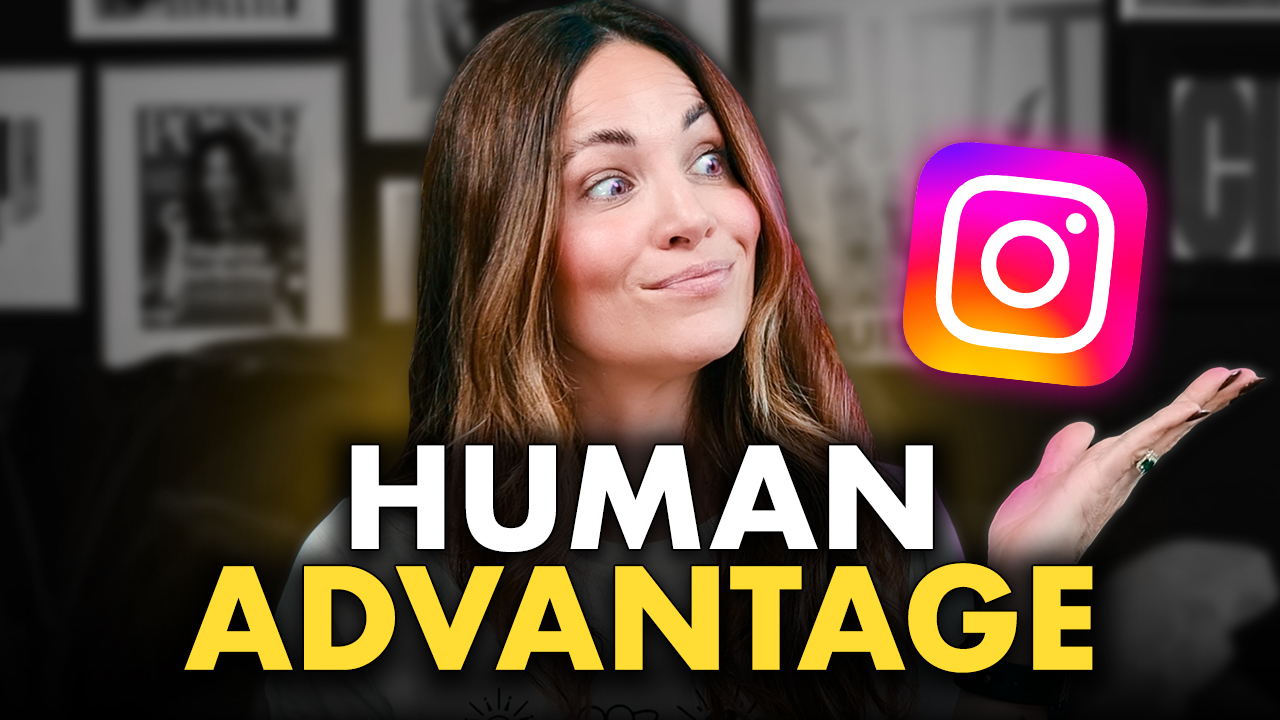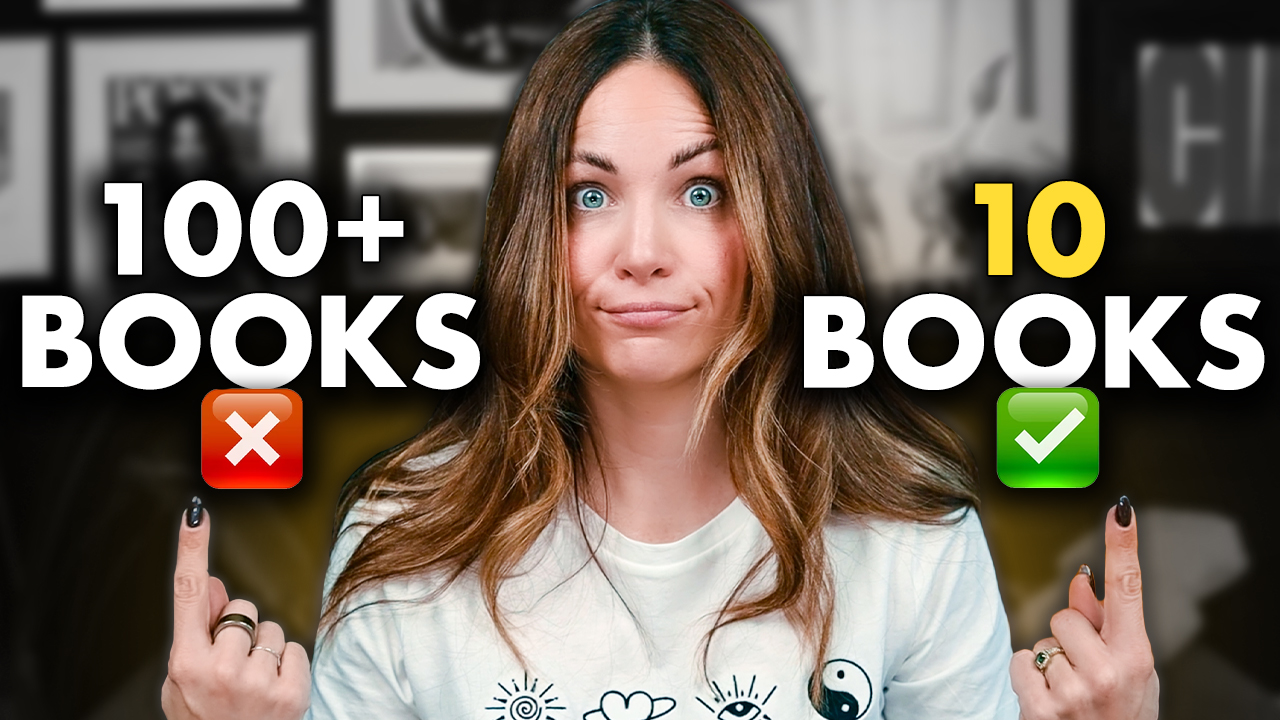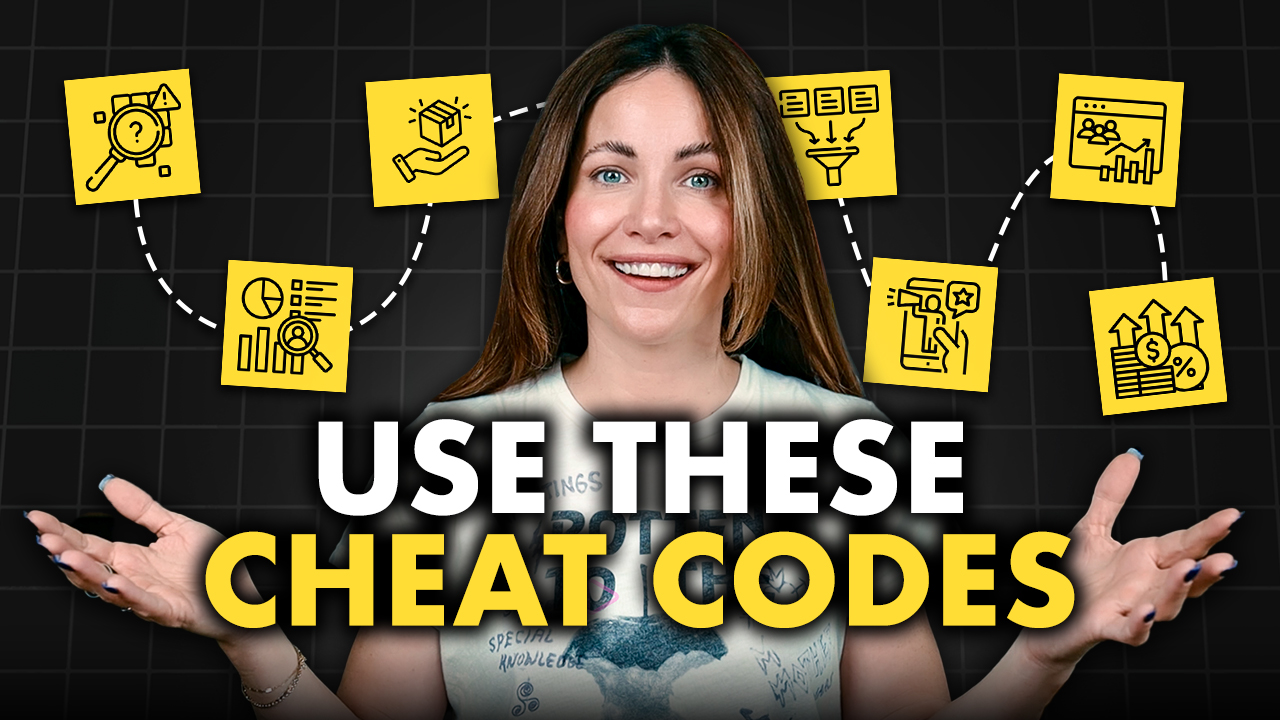Today I’m sharing my 5-step framework for writing winning Facebook ads that get more clicks, generate more leads and stop scrollers dead in their tracks.
If you want to generate more leads, build more brand awareness, and get more customers in your online business what’s the number one thing you need most…?
Traffic.
And how does one get said traffic, you ask?
Well, there are three general sources of traffic:
- Organic Traffic – This is the kind of traffic you get through SEO, word-of-mouth, and content marketing efforts, like social media.
- Referral Traffic – This is when someone else promotes your business through affiliate marketing or endorsements.
- Paid Traffic – This is when brands and businesses spend money on advertising campaigns, like, say, purchasing Facebook Ads or banner ad placements on other high-traffic sites…
And THAT is the focus of today’s blog– writing ads that stand out, get clicks and create long-term leads and customers… but the thing is, crafting a good ad is easier said than done.
Did you know the average person is bombarded with over 1,700 banner ads every single month…
1,700!!!
Unless you use some sort of ad blocking software, you are constantly being shown ads, but…
Think about it for a second… in the last month how many ads do you actually remember seeing? Definitely NOT 1,700… right? Or was it?
Here’s the thing, you only actually register a tiny percentage of the ads you see…
The rest of them were immediately rendered as unimportant by your subconscious mind and basically ignored. I mean, how often do you see a pop-up ad, banner ad, or Facebook ad and just scroll right by without giving it a second thought?…
Your brain has essentially been conditioned to “filter” out this excess noise and for good reason!
Which begs the question… if ads are one of the most important aspects of a marketing funnel… (which they def are)… but only a tiny fraction of ads are actually being seen, read, and engaged with…
HOW IN THE WORLD do you run a successful ad campaign?!
Well, I’ve seen good ads… and I’ve seen bad ads.
And knowing how to write a good ad is of course incredibly important.
In this article, I’m going to talk about the 5-Step Framework that all good ads have in common…
Hey guys, what’s up? It’s Alex!
Welcome to my blog. If you’re new to the crew, hello! I’m so glad you’re here.
I put out a new copywriting and marketing tutorial every single week, so if you’re a copywriter, freelancer, or business owner looking to scale your business with words that work, then go ahead and subscribe to my newsletter. Then you’ll be notified when my next tutorial goes up.
So in today’s article, I’m going to teach you my proven 5-step framework for writing ads that capture attention, stop scrolls, and generate those clicks…
And I’ll walk you through what these components look like, using examples of real-life Facebook ads that I found on my feed.
Because let’s just be honest, most of us are visual learners and we learn better by actually seeing this stuff in action—am I right?
Drop me a comment below if you LOVE examples… and let’s dive in.
We’ll start off with the most important part of any ad…
#1 The Hook
Your Ad is often the very first touchpoint that a new lead has with your brand, product, or service… so it goes without saying that you want your ad to cut through those subconscious “ignore” filters, grab attention and make a lasting first impression.
You do this with a powerful hook.
The hook or “big idea” is the single most important part of ANY copy you write…
But unlike most pieces of copy where your hook is part of your headline because it’s the first thing people read…
When it comes to Facebook Ads, the headline (or what’s referred to as the ad title) is actually way down at the bottom of the ad, below the ad image or video.
Which means by the time your prospect sees your headline, they’re already scrolling past it.
So when writing Facebook ads your hook needs to be in the first sentence of your ad text, which is what readers see FIRST – at the top of the ad.
And you have exactly 125 characters to grab attention and pique curiosity before your text is cut-off with a “read more” link…
In Facebook ad land, these 125 characters are everything and are the part of your ad that you should dedicate most of your creative energy to.
Remember, the goal is to grab attention, generate curiosity, and hook your prospect into reading more.
Let’s look at this example, from Mindvalley.

They immediately grab your attention with the very first line that says “Where 90% of your distractions really come from *hint: it’s not Netflix or notifications*
This is great because it really opens a loop and makes you want to keep reading to find out what exactly IS causing all your distractions.
In a sales page or landing page, this would make a great headline.
So now let’s move onto the next very important part of your ad…
#2 The Ad Body Copy
This is essentially the rest of your ad text or ad caption.
The goal of the ad body copy is to present a solution to a problem, create empathy and connection, and open another loop to make the reader want to click to learn more…
Pro tip: Every single step of your ad and subsequent marketing funnel needs to open a loop to get your prospect to take another action.
So think of the first 125 characters of your ad like a subject line of an email, whereas your ad body copy is the email copy itself, which should then entice someone to click the link or call-to-action.
Now in terms of length, this section is going to vary quite a lot depending on the level of your customer’s awareness and the type of ad it is.
If you aren’t already familiar with Eugene Schwartz’s 5 levels of customer awareness, let me do a quick recap for you:
- Totally unaware – The audience has no idea that they even have a problem or pain worth solving.
- Problem aware – The audience is aware of their problem, but they don’t know a solution exists.
- Solution aware – The audience knows the results they want and are actively seeking solutions.
- Product aware – The audience is familiar with your product and its features, but they aren’t sure it’s right for them.
- Very aware – The audience knows what they want, and they’re ready to buy.
Typically, the more aware your audience is—the shorter your ad can be because less education and indoctrination are needed.
So let’s look at a few ad examples, one for each level of customer awareness.
Okay, first up is totally unaware – at this stage of customer awareness, your copy must educate first and offer a healthy amount of explanation, story and/or evidence. Here’s a great example from Numerologist.com

Here they’ve included a story in the beginning of their ad, to hook the reader in and generate interest & curiosity.
Then they move into a bit of education around numerology—which isn’t as widely known or understood as something like Astrology for example.
Then they finish off their story and end with another open loop and invitation to the reader. It’s awesome.
Next, let’s look at an ad that is directed to a more problem-aware audience. At this stage of customer awareness, you want to empathize with your prospect’s pain, introduce your solution, and offer strong benefits. This ad from DigitalMarketer is a great example of a problem-aware ad.

Starting at the top, they empathize with the pain point of how hard it is to position yourself strongly in the competitive field of marketing.
Then they introduce their solution, the Digital Marketing Mastery training course.
And they finish by offering some really strong benefits, sharing that you’ll be able to “profitably drive awareness, leads, sales, and referrals—EVERYTHING you need to become a master of digital marketing”.
Then incentivizing the audience further at the end with a limited-time offer that generates scarcity.
Next up, let’s look at a more solution-aware ad.
Remember at this stage of customer awareness, your prospects are evaluating options and aren’t yet sure if your product can help them. So you want to showcase social proof, build trust and communicate your unique value proposition – or USP.
This ad from Larq is a great example of a solution-aware ad…
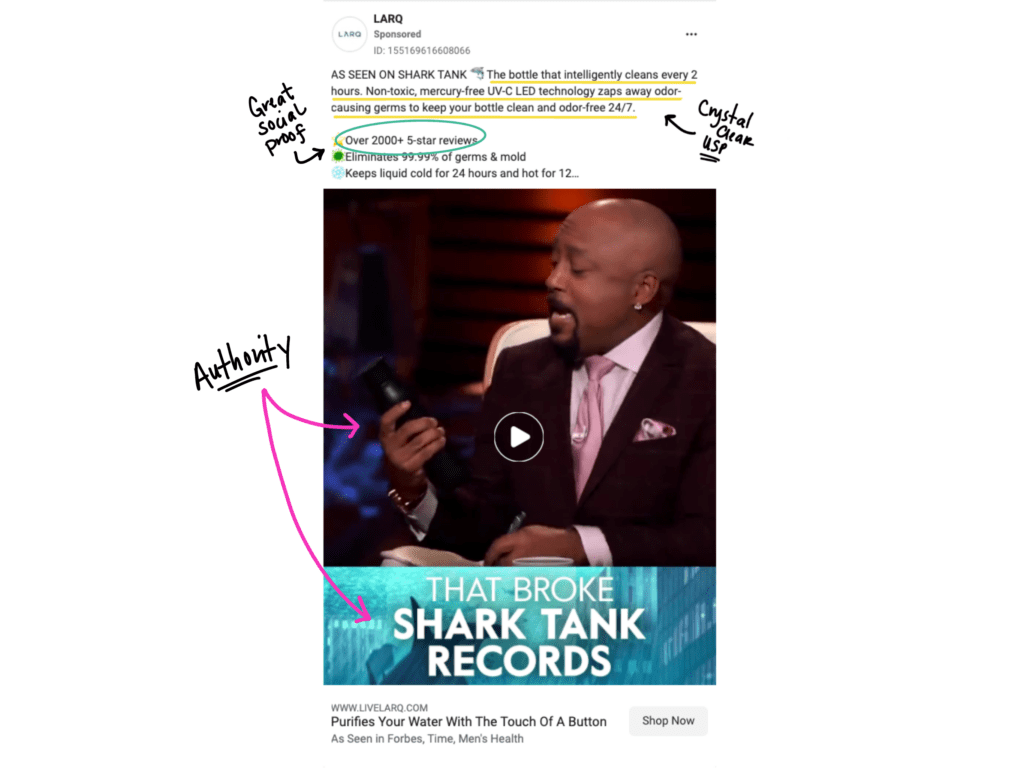
Showcasing social proof with “over 2000+ 5-star reviews.”
Building trust and highlighting authority by playing up their Shark Tank features, even stating that they “broke Shark Tank records”.
And they clearly communicate their USP, “the bottle that intelligently cleans every 2 hours. Non-toxic, mercury-free UV C LED technology zaps away odor-causing germs to keep your bottle clean and odor-free 24/7.”
Okay, and here’s a great example of a product-aware ad from Yoga International.

Remember, at this stage, your readers have connected their pain with your solution, but aren’t yet sure it’s right for them. So you want to highlight scarcity and incentive in your copy.
Yoga International does a great job of giving incentive here, “30 days of free yoga” and they highlight scarcity too, mentioning that the offer is ending soon.
And our last ad example here is for a very aware audience.
Writing copy for a very aware audience is pretty darn easy because your product is already widely known to the audience you’re marketing to.
All you really have to do is present your product and ask them to buy.
This super simple ad from Nike is a great example of copy for a very aware audience. It has just one line…

Ready to one-up your workout? With a CTA to shop now.
Speaking of CTA, the next important part of your ad is your CTA. Or what I call…
#3 The Stinger
Above and beyond the standard CTA button that appears in all Facebook ads, you want to use the last couple of sentences of your ad body copy to open a loop and entice the reader to follow through and click…
Here’s an example from Susie Moore.

She uses the last few sentences of her ad to really drive home and recap on the pain points of the audience – which is getting media attention to your business.
She introduces her solution, which is a free training that teaches you how to do it easily.
And then she presents a clear and concise CTA for the audience to take—click here to register for free today.
#4 The Ad Creative
Obviously, the ad image or video is a hugely important part of any ad, but is something that you won’t necessarily have to worry about as a copywriter.
Your client will decide on the imagery that they want to use to accompany the ad copy. Although, if you have any good ideas when you’re writing the ad, then you’re more than welcome to share that feedback with your client!
Where you come in as a copywriter is if your client chooses to use an ad image and wants to include any copy on that image.
The ad image text is often the most read part of any ad, so the number rule here is to keep it short and use a powerful hook…
In this example, Beauty Counter keeps the copy in their ad body short, but powerfully communicates the benefits the user can expect from this hand cream meets hand sanitizer duo—hydrate, boost brightness, kill 99.99% of bacteria, and it’s the perfect size to travel with.
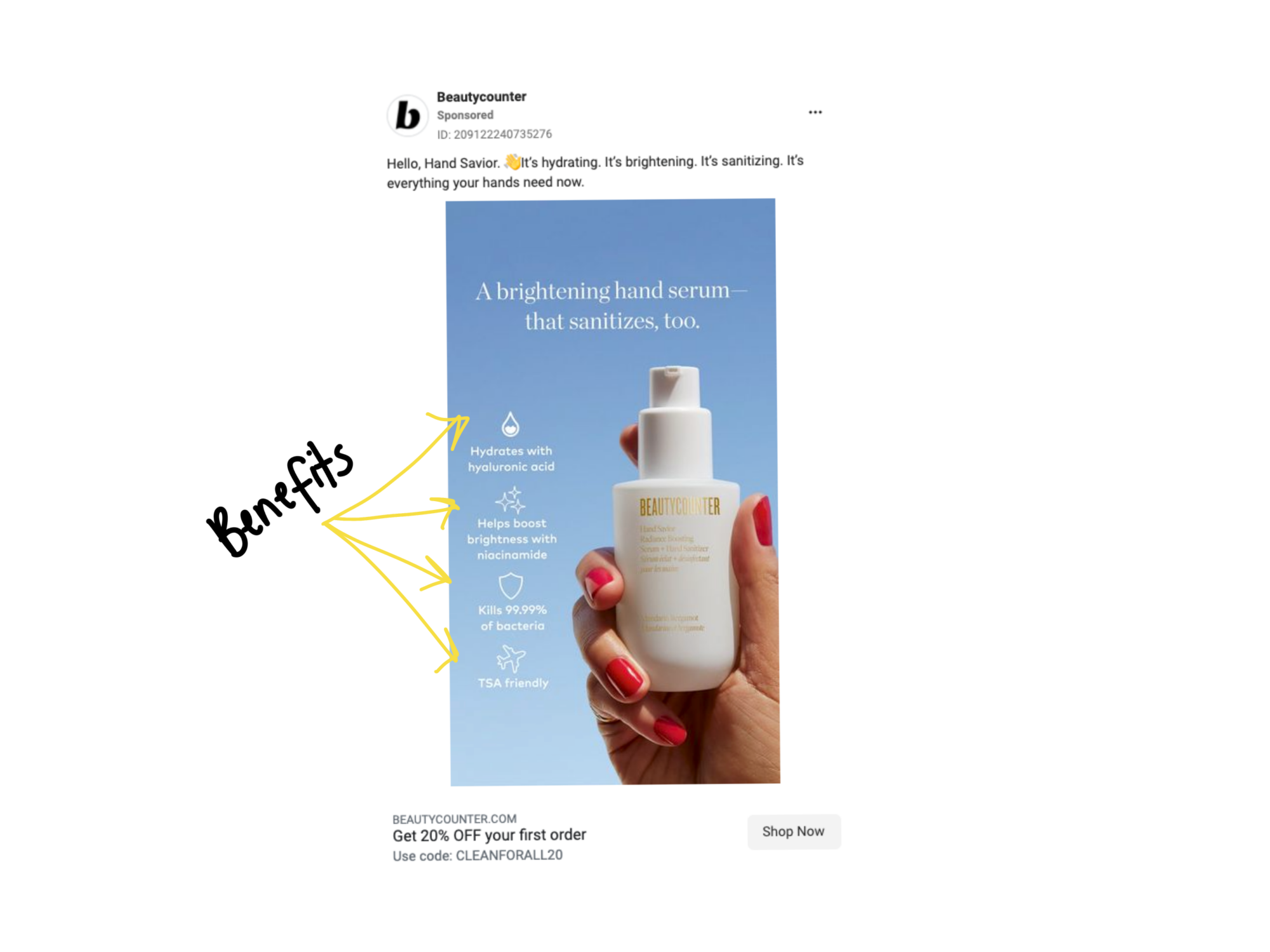
#5 The Ad Title & Description
Like I said, down at the bottom is where your ad headline—aka your ad title—and description will go.
Now, what’s really important here….and this is a mistake that I see being made way too often, is to make sure that your ad title and description are saying something DIFFERENT otherwise you’re just wasting precious ad real estate.
I surprisingly see this done all of the time. Ads that say the exact same thing in their title and their description.
Or even worse—ads that are only utilizing ONE of these options. Like this one from MindBodyGreen.

Now I’m a big fan of MindBodyGreen, but they don’t have an ad description here at all. They are assuming their audience will watch the video, and that they will watch the entire video.
MindBodyGreen could make this ad way more powerful by adding a description here that says something like, “Enroll today and save $300”—which is the incentive they show and the very end of this video.
Always make sure that you’re taking full advantage of your ad space. Oh yeah, and never make assumptions about your viewers.
So when it comes to the ad title and description—what SHOULD you do?
You want your title and description to be clear and concise. You have a few options here: communicating the offer (or what the prospect is getting) a strong bennie or two (or giving them a powerful incentive to act now).
And remember, you only have a very limited amount of space to do this. So don’t try to cram all of that in there. Just pick 1 thing to focus on for the headline, and a different thing to focus on for the description.
Here’s a good example from Alo Moves.

The headline is “10-Minute Stackable Workouts”—which is great because it clearly states what you’re getting.
The description shares who the trainer is, which is great, but in my opinion, this could actually be a bit stronger by eliminating “on Alo Moves”—which feels redundant—and putting in a strong benny instead. So something like “train with Harley Pasternak and get sculpted”.
But overall this is a good example of what you want your headline and description to be.
And also, here’s a quick tip for ya:
Keep your headline to 25 characters and your description to 30 characters to avoid having your text cut off by Facebook.
Now, if you’re looking for more great content on writing ads, here’s the link to my video on how the 5 components to writing a good ad.
Watch This Instead
Until next time, I’m Alex – ciao for now!
